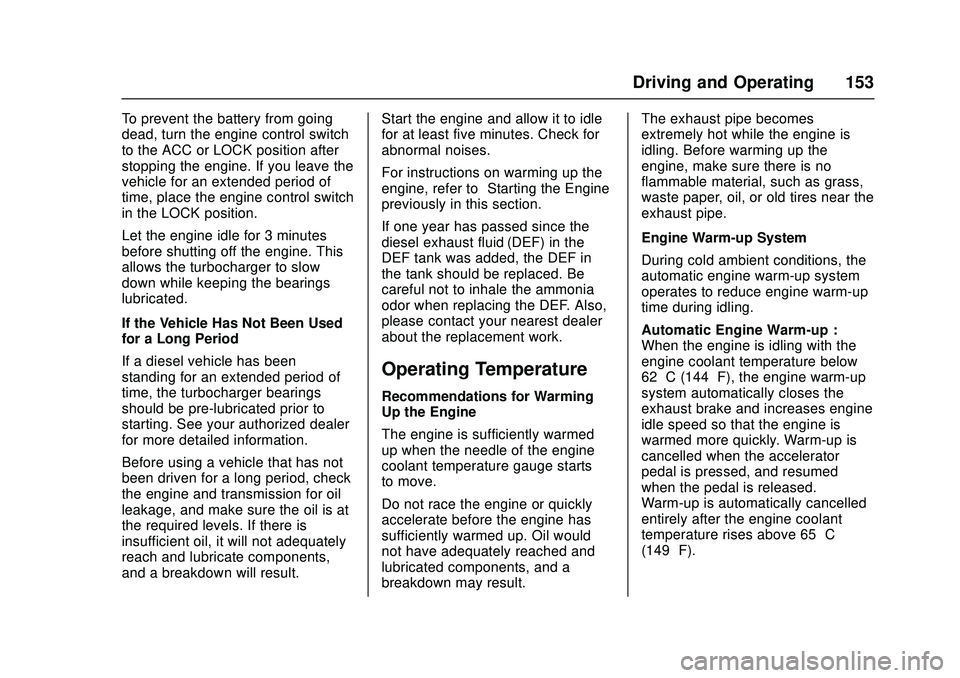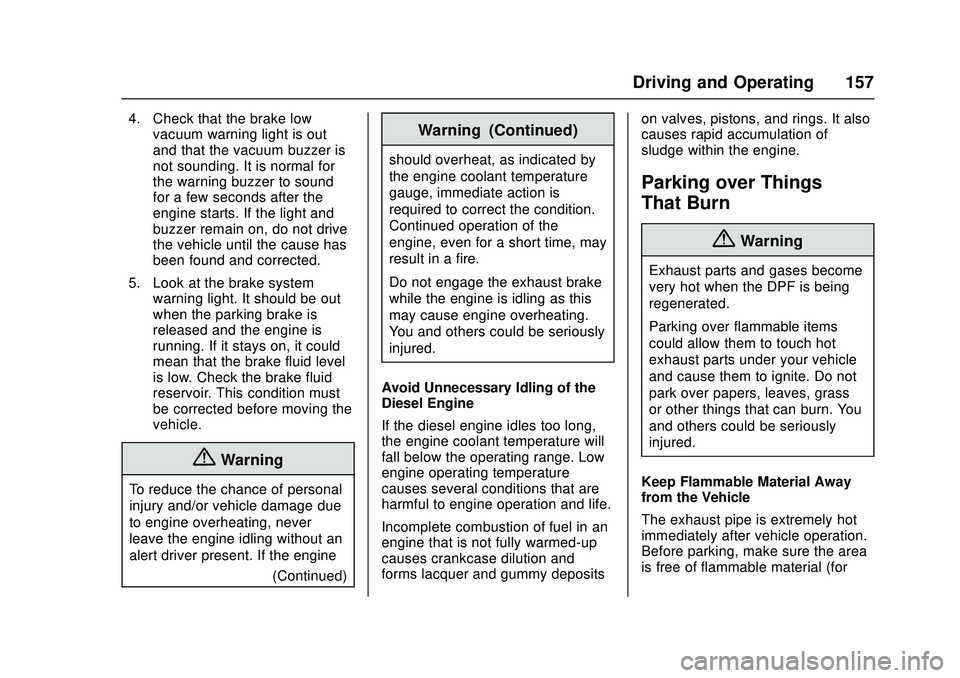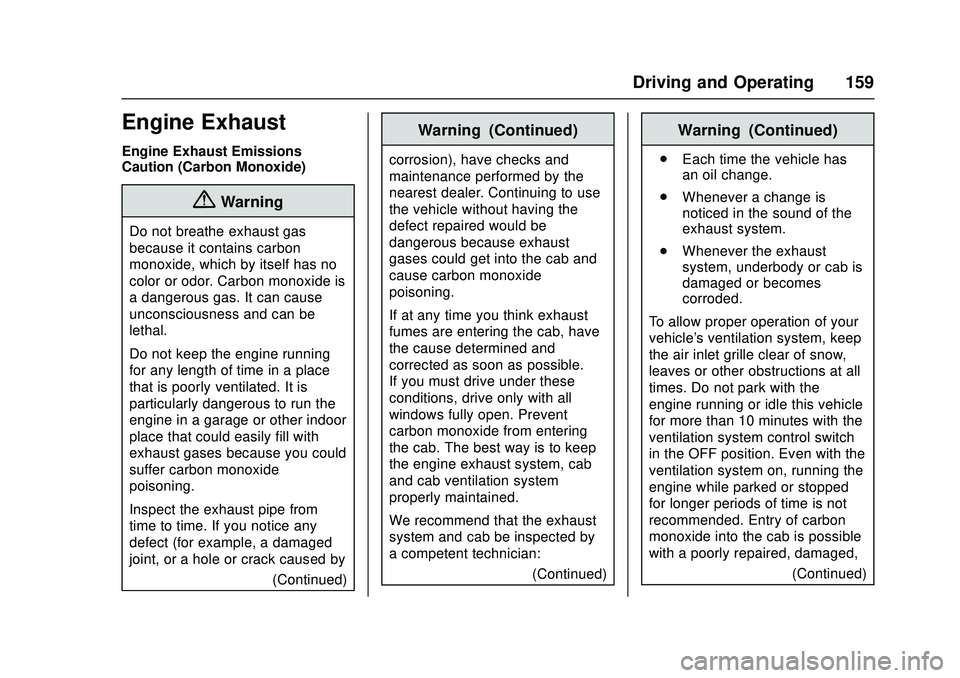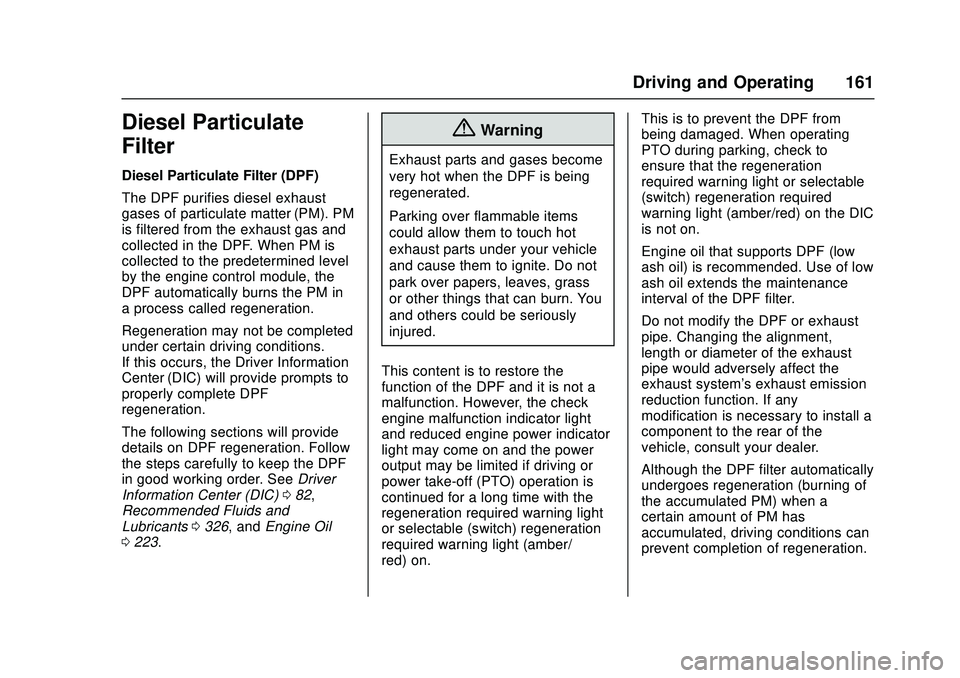check engine CHEVROLET LOW CAB FORWARD 2018 Service Manual
[x] Cancel search | Manufacturer: CHEVROLET, Model Year: 2018, Model line: LOW CAB FORWARD, Model: CHEVROLET LOW CAB FORWARD 2018Pages: 358, PDF Size: 6.32 MB
Page 152 of 358

Chevrolet Low Cab Forward Owner Manual (GMNA-Localizing-U.S.-
11254764) - 2018 - crc - 12/5/16
Driving and Operating 151
2. When the engine control switchis turned to the ON position,
the wait-to-start light comes on
and it goes out in about
1 second when the engine is
warm, to about 10 seconds
when the engine is cold.
3. After confirming that the wait-to-start light has gone out,
turn the engine control switch
to the START position to start
the engine. Release the engine
control switch as soon as the
engine starts.
4. Do not crank the engine for more than 10 seconds at a
time. If the engine does not
start, wait 20 to 30 seconds
with the engine control switch
in the LOCK or ACC position
before trying to start again. It is normal for the vacuum warning
buzzer to sound for a few seconds
after the engine has started.
After the engine has started, check
to be sure the selector lever is still
in the P position.
This engine has an automatic
warm-up system that increases
engine idle speed and applies the
exhaust brake. Allow sufficient time
to let the engine circulate lubricant
oil before driving. This usually
requires 30 seconds to 2 minutes
depending on ambient conditions.
See
Brake System Warning Light
(Parking Brake Light) 075.
The turbocharged engine should be
started in a way which ensures the
bearings supporting the rotating
parts of the turbocharger are
sufficiently lubricated. Do not race a
cold engine.
At low ambient temperatures, a cold
engine may emit more smoke than
usual.
Do not drive the truck until the
engine has had sufficient time to
circulate the lubricant oil. This usually requires 30 seconds to
2 minutes depending on ambient
conditions. This will help reduce
white start-up smoke.
Preheating :
Diesel engines are
compression ignited, which makes
them difficult to start when they are
cold because the compression
alone cannot create a temperature
high enough for fuel to ignite.
Preheating means warming the
compressed air inside the
combustion chambers to facilitate
engine starting. Be sure to start the
engine after the wait-to-start light
has gone out.
Start : Do not press the accelerator
pedal at the engine start. The
accelerator opening degree at the
engine start is electronically
controlled.
Warm-up : Do not race the engine
to speed warm-up.
Page 154 of 358

Chevrolet Low Cab Forward Owner Manual (GMNA-Localizing-U.S.-
11254764) - 2018 - crc - 12/5/16
Driving and Operating 153
To prevent the battery from going
dead, turn the engine control switch
to the ACC or LOCK position after
stopping the engine. If you leave the
vehicle for an extended period of
time, place the engine control switch
in the LOCK position.
Let the engine idle for 3 minutes
before shutting off the engine. This
allows the turbocharger to slow
down while keeping the bearings
lubricated.
If the Vehicle Has Not Been Used
for a Long Period
If a diesel vehicle has been
standing for an extended period of
time, the turbocharger bearings
should be pre-lubricated prior to
starting. See your authorized dealer
for more detailed information.
Before using a vehicle that has not
been driven for a long period, check
the engine and transmission for oil
leakage, and make sure the oil is at
the required levels. If there is
insufficient oil, it will not adequately
reach and lubricate components,
and a breakdown will result.Start the engine and allow it to idle
for at least five minutes. Check for
abnormal noises.
For instructions on warming up the
engine, refer to
“Starting the Engine”
previously in this section.
If one year has passed since the
diesel exhaust fluid (DEF) in the
DEF tank was added, the DEF in
the tank should be replaced. Be
careful not to inhale the ammonia
odor when replacing the DEF. Also,
please contact your nearest dealer
about the replacement work.
Operating Temperature
Recommendations for Warming
Up the Engine
The engine is sufficiently warmed
up when the needle of the engine
coolant temperature gauge starts
to move.
Do not race the engine or quickly
accelerate before the engine has
sufficiently warmed up. Oil would
not have adequately reached and
lubricated components, and a
breakdown may result. The exhaust pipe becomes
extremely hot while the engine is
idling. Before warming up the
engine, make sure there is no
flammable material, such as grass,
waste paper, oil, or old tires near the
exhaust pipe.
Engine Warm-up System
During cold ambient conditions, the
automatic engine warm-up system
operates to reduce engine warm-up
time during idling.
Automatic Engine Warm-up :
When the engine is idling with the
engine coolant temperature below
62 °C (144 °F), the engine warm-up
system automatically closes the
exhaust brake and increases engine
idle speed so that the engine is
warmed more quickly. Warm-up is
cancelled when the accelerator
pedal is pressed, and resumed
when the pedal is released.
Warm-up is automatically cancelled
entirely after the engine coolant
temperature rises above 65 °C
(149 °F).
Page 157 of 358

Chevrolet Low Cab Forward Owner Manual (GMNA-Localizing-U.S.-
11254764) - 2018 - crc - 12/5/16
156 Driving and Operating
Activating High Idle Mode
Follow the below procedure to
activate the high idle mode:1. Set the parking brake.
2. Set the selector lever in P (Park) or N (Neutral) position.
3. Do not press the brake pedal. 4. Press the cruise control main
switch to set it to ON. At this
time, the operation indicating
light will turn to green.
5. Turn and hold the cruise control set switch in the SET
position. After approximately
3 seconds the cruise control
set indicator light will begin to
flash slowly and the engine idle
will increase to 1,200 r/min.
Canceling High Idle Mode
Any of the following actions will
cancel high idle mode.
. The cruise control main switch is
set to OFF.
. The brake pedal is pressed.
. The parking brake is released.
. The selector lever is moved from
P (Park) or N (Neutral) position.
. The accelerator pedal is
pressed, accelerating the engine
beyond the engine speed
threshold.
The cruise set indicator light will
stop flashing and the engine speed
will return to normal.
Engine Checks Before
Operating
Checks Before Operating
Allow the engine to warm up before
placing the engine under heavy load
driving. While the engine is warming
up under light load, the following
checks should be made:
1. Observe the red engine oil pressure warning light. The
light should go out when the
engine is running. If it stays on,
shut the engine off and find the
cause.
2. Look at the engine coolant temperature gauge. If the
gauge reaches the H (HOT)
area, stop the engine and find
the cause of the overheating.
3. Check that the battery warning light has gone out. The light
should go off and stay off at
normal idle speeds. If the light
does not go out or comes on
during normal operation, have
the charging system checked.
Page 158 of 358

Chevrolet Low Cab Forward Owner Manual (GMNA-Localizing-U.S.-
11254764) - 2018 - crc - 12/5/16
Driving and Operating 157
4. Check that the brake lowvacuum warning light is out
and that the vacuum buzzer is
not sounding. It is normal for
the warning buzzer to sound
for a few seconds after the
engine starts. If the light and
buzzer remain on, do not drive
the vehicle until the cause has
been found and corrected.
5. Look at the brake system warning light. It should be out
when the parking brake is
released and the engine is
running. If it stays on, it could
mean that the brake fluid level
is low. Check the brake fluid
reservoir. This condition must
be corrected before moving the
vehicle.
{Warning
To reduce the chance of personal
injury and/or vehicle damage due
to engine overheating, never
leave the engine idling without an
alert driver present. If the engine
(Continued)
Warning (Continued)
should overheat, as indicated by
the engine coolant temperature
gauge, immediate action is
required to correct the condition.
Continued operation of the
engine, even for a short time, may
result in a fire.
Do not engage the exhaust brake
while the engine is idling as this
may cause engine overheating.
You and others could be seriously
injured.
Avoid Unnecessary Idling of the
Diesel Engine
If the diesel engine idles too long,
the engine coolant temperature will
fall below the operating range. Low
engine operating temperature
causes several conditions that are
harmful to engine operation and life.
Incomplete combustion of fuel in an
engine that is not fully warmed-up
causes crankcase dilution and
forms lacquer and gummy deposits on valves, pistons, and rings. It also
causes rapid accumulation of
sludge within the engine.
Parking over Things
That Burn
{Warning
Exhaust parts and gases become
very hot when the DPF is being
regenerated.
Parking over flammable items
could allow them to touch hot
exhaust parts under your vehicle
and cause them to ignite. Do not
park over papers, leaves, grass
or other things that can burn. You
and others could be seriously
injured.
Keep Flammable Material Away
from the Vehicle
The exhaust pipe is extremely hot
immediately after vehicle operation.
Before parking, make sure the area
is free of flammable material (for
Page 160 of 358

Chevrolet Low Cab Forward Owner Manual (GMNA-Localizing-U.S.-
11254764) - 2018 - crc - 12/5/16
Driving and Operating 159
Engine Exhaust
Engine Exhaust Emissions
Caution (Carbon Monoxide)
{Warning
Do not breathe exhaust gas
because it contains carbon
monoxide, which by itself has no
color or odor. Carbon monoxide is
a dangerous gas. It can cause
unconsciousness and can be
lethal.
Do not keep the engine running
for any length of time in a place
that is poorly ventilated. It is
particularly dangerous to run the
engine in a garage or other indoor
place that could easily fill with
exhaust gases because you could
suffer carbon monoxide
poisoning.
Inspect the exhaust pipe from
time to time. If you notice any
defect (for example, a damaged
joint, or a hole or crack caused by(Continued)
Warning (Continued)
corrosion), have checks and
maintenance performed by the
nearest dealer. Continuing to use
the vehicle without having the
defect repaired would be
dangerous because exhaust
gases could get into the cab and
cause carbon monoxide
poisoning.
If at any time you think exhaust
fumes are entering the cab, have
the cause determined and
corrected as soon as possible.
If you must drive under these
conditions, drive only with all
windows fully open. Prevent
carbon monoxide from entering
the cab. The best way is to keep
the engine exhaust system, cab
and cab ventilation system
properly maintained.
We recommend that the exhaust
system and cab be inspected by
a competent technician:(Continued)
Warning (Continued)
.Each time the vehicle has
an oil change.
. Whenever a change is
noticed in the sound of the
exhaust system.
. Whenever the exhaust
system, underbody or cab is
damaged or becomes
corroded.
To allow proper operation of your
vehicle's ventilation system, keep
the air inlet grille clear of snow,
leaves or other obstructions at all
times. Do not park with the
engine running or idle this vehicle
for more than 10 minutes with the
ventilation system control switch
in the OFF position. Even with the
ventilation system on, running the
engine while parked or stopped
for longer periods of time is not
recommended. Entry of carbon
monoxide into the cab is possible
with a poorly repaired, damaged, (Continued)
Page 162 of 358

Chevrolet Low Cab Forward Owner Manual (GMNA-Localizing-U.S.-
11254764) - 2018 - crc - 12/5/16
Driving and Operating 161
Diesel Particulate
Filter
Diesel Particulate Filter (DPF)
The DPF purifies diesel exhaust
gases of particulate matter (PM). PM
is filtered from the exhaust gas and
collected in the DPF. When PM is
collected to the predetermined level
by the engine control module, the
DPF automatically burns the PM in
a process called regeneration.
Regeneration may not be completed
under certain driving conditions.
If this occurs, the Driver Information
Center (DIC) will provide prompts to
properly complete DPF
regeneration.
The following sections will provide
details on DPF regeneration. Follow
the steps carefully to keep the DPF
in good working order. SeeDriver
Information Center (DIC) 082,
Recommended Fluids and
Lubricants 0326, and Engine Oil
0 223.
{Warning
Exhaust parts and gases become
very hot when the DPF is being
regenerated.
Parking over flammable items
could allow them to touch hot
exhaust parts under your vehicle
and cause them to ignite. Do not
park over papers, leaves, grass
or other things that can burn. You
and others could be seriously
injured.
This content is to restore the
function of the DPF and it is not a
malfunction. However, the check
engine malfunction indicator light
and reduced engine power indicator
light may come on and the power
output may be limited if driving or
power take-off (PTO) operation is
continued for a long time with the
regeneration required warning light
or selectable (switch) regeneration
required warning light (amber/
red) on. This is to prevent the DPF from
being damaged. When operating
PTO during parking, check to
ensure that the regeneration
required warning light or selectable
(switch) regeneration required
warning light (amber/red) on the DIC
is not on.
Engine oil that supports DPF (low
ash oil) is recommended. Use of low
ash oil extends the maintenance
interval of the DPF filter.
Do not modify the DPF or exhaust
pipe. Changing the alignment,
length or diameter of the exhaust
pipe would adversely affect the
exhaust system's exhaust emission
reduction function. If any
modification is necessary to install a
component to the rear of the
vehicle, consult your dealer.
Although the DPF filter automatically
undergoes regeneration (burning of
the accumulated PM) when a
certain amount of PM has
accumulated, driving conditions can
prevent completion of regeneration.
Page 165 of 358

Chevrolet Low Cab Forward Owner Manual (GMNA-Localizing-U.S.-
11254764) - 2018 - crc - 12/5/16
164 Driving and Operating
The DPF performs regeneration
automatically when a certain
quantity of PM accumulates in the
filter.
Depending upon running conditions,
however, the regeneration may
sometimes not be completed. In this
case, the regeneration required
warning light (amber) will come on,
so promptly operate the emergency
regeneration according to the
Emergency Regeneration
Procedure. This operation recovers
the function of the DPF. It does not
mean that a breakdown has
occurred.
The engine speed may increase
and the exhaust brake may activate
while the vehicle is stopped with the
engine idling. When this occurs, the
DPF is automatically regenerated.
This does not indicate a failure.
The system generates a sound
during the automatic regeneration
and its cancellation. This does not
indicate a failure.DPF SwitchThe DPF switch is used to burn PM
(regenerate the filter). You can
initiate regeneration when the
regeneration required warning light
or selectable (switch) regeneration
required warning light turns on with
short repeated beeps.
Continuing driving without
performing the regeneration will
cause the check engine malfunction
indicator light and reduced engine
power indicator light to come on.
The DPF then must be repaired at
the nearest dealer.
Emergency Regeneration
Procedure
If the regeneration required warning
light (amber) or selectable (switch)
regeneration required warning light
(amber) turns on the DIC, the DPF
could not satisfactorily complete
automatic regeneration and driver
action is required. If the
regeneration required warning light
(Not selectable (switch)
regeneration warning light) is turned
on, you can choose from Running
Page 166 of 358

Chevrolet Low Cab Forward Owner Manual (GMNA-Localizing-U.S.-
11254764) - 2018 - crc - 12/5/16
Driving and Operating 165
regeneration or Switch regeneration
in order to complete the DPF
regeneration.
If the selectable (switch)
regeneration required warning light
turns on, you have to perform
Switch regeneration in order to
complete the DPF regeneration.
If you continue driving too long with
the regeneration required warning
light (amber) or selectable (switch)
regeneration required warning light
(amber) displayed on the DIC
without performing one of the
possible regenerations, the
message will change to red
Regeneration Required warning
light or selectable (switch)
regeneration required warning light.
The red regeneration required
warning light or selectable (switch)
regeneration required warning light
indicates the DPF filter is nearly full
of PM, a condition which may be
damaging to the filter.
DPF regeneration should be
completed immediately if the red
regeneration required warning lightor selectable (switch) regeneration
required warning light is displayed
on the DIC.
Continuing to drive without
performing DPF regeneration will
cause the check engine malfunction
indicator light and reduced engine
power indicator light to come on, an
engine power reduction, and may
cause damage to the DPF filter. See
Driver Information Center (DIC)
0
82.
Running Regeneration Procedure
Use this option for completing DPF
regeneration, if driving conditions
and traffic allow you to maintain a
relatively constant speed above
48 km/h (30 MPH) for about
20 minutes.
Follow the steps below to use
Running regeneration: 1. Determine if road and traffic conditions allow for relatively
constant speeds above
48 km/h (30 MPH).
2. Increase the vehicle speed above 48 km/h (30 MPH) and
keep a constant speed. 3. When vehicle speed, engine
coolant temperature and other
factors are met the engine
control module (ECM) will
begin DPF regeneration and
the regeneration in progress
indicator light (amber) will
appear on the DIC.
4. Continue driving until the regeneration in progress
indicator light (amber) goes off.
When this indicator light goes
off the DPF regeneration is
complete.
See Driver Information Center (DIC)
0 82.
While the vehicle is at a stop with
engine idling, the engine speed
increases.
Switch Regeneration Procedure
Page 168 of 358

Chevrolet Low Cab Forward Owner Manual (GMNA-Localizing-U.S.-
11254764) - 2018 - crc - 12/5/16
Driving and Operating 167
Continued driving without
performing DPF regeneration will
cause the check engine malfunction
indicator light and reduced engine
power indicator light to come on, an
engine power reduction, and may
cause damage to the DPF filter. See
Driver Information Center (DIC)
082.
When operating the PTO for a long
time if your vehicle is so equipped,
make sure that the regeneration
required warning light or selectable
(switch) regeneration required
warning light (amber) is not
turning on.
Once the Switch regeneration is
started, it cannot be switched to the
Running regeneration if interrupted.
When the Switch regeneration is
selected, end regeneration in a
single operation if possible.
During the regeneration, the engine
speed may vary, causing the
exhaust brake valve to be
deactivated. However, while the
regeneration in progress indicator
light (amber) appears, regeneration is still taking place, so continue to
perform regeneration until the
message goes off.
The time needed to complete
regeneration differs depending on
the outside temperature.
The exhaust brake or exhaust
throttle is activated during DPF
regeneration. The exhaust brake or
exhaust throttle starting to operate
or being disengaged will produce a
sound, but this does not indicate a
failure.
During regeneration, white smoke
may be temporarily produced from
the exhaust pipe. This results from
combustion of PM, it does not
indicate a failure.
Switch regeneration will complete
earlier immediately after driving than
when the engine is cold.
The engine coolant temperature
may rise during switch regeneration.
Interruption of Switch
Regeneration
If you must interrupt regeneration for
an unavoidable reason, press the
DPF switch again.
The regeneration in progress
indicator light (amber) changes to
the selectable (switch) regeneration
required warning light (amber).
Then, you can drive the vehicle.
If you interrupt regeneration, you
need to perform regeneration again.
Perform switch regeneration
beginning with Step 1 as soon as
possible.
Switch regeneration will be
interrupted in the following
circumstances:
.
Accelerator pedal is pressed.
. Gear-in.
. Vehicle speed is above
0 km/h (0 MPH).
. Engine speed increases.
Operation noise caused by
interruption is louder when pressing
the accelerator pedal than other
operations. This is not a failure.
Page 170 of 358

Chevrolet Low Cab Forward Owner Manual (GMNA-Localizing-U.S.-
11254764) - 2018 - crc - 12/5/16
Driving and Operating 169
3. Run the engine at idle. Be surethe accelerator pedal is not
pressed and the PTO switch (if
equipped) is OFF.
4. Press and hold the DPF switch until the amber checking PM
Level indicator light appears on
the DIC.
5. If Selectable regeneration is available, the selectable
(switch) regeneration required
warning light (amber) will
appear on the DIC. If this
indicator light does not appear
on the DIC, the PM level in the DPF filter is OK and DPF
regeneration is not needed at
this time.
6. Press and release the DPF switch to begin regeneration.
7. The selectable (switch) regeneration required warning
light (amber) will change to
regeneration in progress
indicator light.
8. Do not leave the vehicle during the regeneration. Regeneration
normally completes in about
20 minutes, if the engine is at operating temperature.
Regeneration may take longer
if the engine is cold.
9. When the regeneration in progress indicator light goes
out, the Selectable
regeneration is complete.
If the Selectable regeneration is
interrupted, a selectable (switch)
regeneration required warning light
(amber) will appear on the DIC. You
must complete the DPF
regeneration by performing the
Switch regeneration as soon as
possible when Selectable
regeneration is interrupted.
If you continue driving too long with
the selectable (switch) regeneration
required warning light (amber)
displayed on the DIC, the warning
light will change to red. The
selectable (switch) regeneration
required warning light (red) indicates
the DPF filter is nearly full of PM, a
condition which may be damaging
to the filter. DPF regeneration
should be completed immediately if